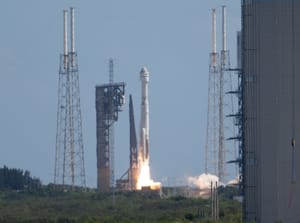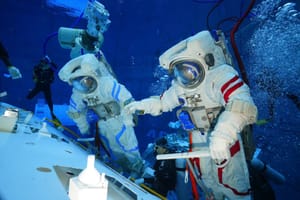
Starliner carries first crew after years of delays
Boeing's Starliner spacecraft has finally carried its first crew into orbit for its first crewed flight test today. The Altas V launch vehicle carrying the spacecraft had an instantaneous launch window and lifted off at 14:52 pm Universal Coordinated Time from Space Launch Complex 41, in Florida.
The United Launch Alliance Atlas V successfully carried the spacecraft out of Earth's atmosphere and onto its desired slightly sub-orbital low Earth orbit, the lowest point of this orbit is just below the atmosphere to allow the Centaur upper-stage to burn up without additional maneuvers. Approximately thirty-three minutes after launch, Starliner completed its first maneuver to raise its orbit to prevent an early re-entry.
Let’s relive liftoff of #AtlasV carrying #Starliner #CFT for @NASA and @BoeingSpace! pic.twitter.com/MxlAZE45aK
— ULA (@ulalaunch) June 5, 2024
Starliner's liftoff atop of Atlas V via United Launch Alliance on X.
NASA Administrator Bill Nelson commented on the successful launch saying:
“Two bold NASA astronauts are well on their way on this historic first test flight of a brand-new spacecraft,” – “Boeing’s Starliner marks a new chapter of American exploration. Human spaceflight is a daring task – but that’s why it’s worth doing. It’s an exciting time for NASA, our commercial partners, and the future of exploration. Go Starliner, Go Butch and Suni!”
While en route to the International Space Station, the two crew onboard Starliner will perform a variety of tests related to manual control before docking procedures begin. The spacecraft is expected to dock at approximately 16:00 pm, Universal Coordinated Time. Starliner's hatch is expected to open two hours after docking, allowing Sunita Willams and Barry Wilmore to interact with the crews onboard the International Space Station.
Who's onboard Starliner?
Sunita Williams - Sunita Willaims is flying aboard Starliner for the flight test on her third trip to space. She first flew to the International Space Station on STS-116, with a return on STS-117 after a one-hundred-and-ninety-two-day stay onboard. Her second trip to space was on Soyuz TMA-05M, which also headed to the International Space Station, where she was onboard for five months.
Barry E. Wilmore - Barry Wilmore is also flying aboard Starliner for the flight test and is also on his third trip to space. He first flew to space aboard STS-129 which delivered cargo to the International Space Station as part of an almost eleven-day mission. His second trip to space was on Soyuz TMA-14M for a one-hundred-and-sixty-six-day stay aboard the International Space Station.

What is Starliner?
Starliner is Boeing's crew capsule that operates under NASA's Commercial Crew program, alongside SpaceX's Crew Dragon. The spacecraft can carry four astronauts and 100 kilograms of cargo to the International Space Station, in an emergency it can support seven astronauts. Astronauts inside the capsule of Starliner have access to eleven cubic meters of space.

Starliner consists of a capsule and a service module. The capsule houses the astronauts and the docking system that allows its passengers to enter the International Space Station. The capsule is also designed to be reused up to ten times with a six-month turnaround between missions. Starliner's service module is expended for each mission, it provides power and propulsion to the spacecraft alongside housing the abort system.
The abort system of Starliner uses four Rocketdyne RS-88 engines burning Monomethylhydrazine and Dinitrogen tetroxide to push the spacecraft away from a failing launch vehicle. Fully fuelled atop of a launch vehicle Starliner weighs approximately 13,000 kilograms
What is Atlas V?
Atlas V is United Launch Alliance's oldest two-stage rocket in service. The rocket is currently planned to be replaced by Vulcan when it retires before 2030.

The first-stage is powered by a single RD-180 generating 390 tons of thrust burning rocket-grade kerosene and liquid oxygen for four minutes and thirteen seconds. The RD-180 is manufactured by NPO Energomash in Russia.
The second-stage is powered by either one or two RL-10 engines generating 10 tons of thrust each while burning liquid hydrogen and liquid oxygen for fourteen minutes and two seconds. Aerojet Rocketdyne, an L3Harris Technologies Company, manufactures the RL-10 engines.
Atlas V can also launch with between zero and five GEM-63 solid rocket motors to augment the rocket's thrust and payload capability. Each booster burns a solid propellant, consisting of Hydroxyl-terminated polybutadiene and Aluminum-Ammonium perchlorate, generating 169 tons of thrust each for a believed one minute and thirty-four seconds. Northrop Grumman manufactures the solid rocket boosters for use with United Launch Alliance.
Atlas V also has eleven different configurations with the following payload capacities: up to 18,850 kilograms to low Earth orbit, up to 8,900 kilograms to geostationary transfer orbit, or up to 3,850 kilograms to geostationary orbit.



